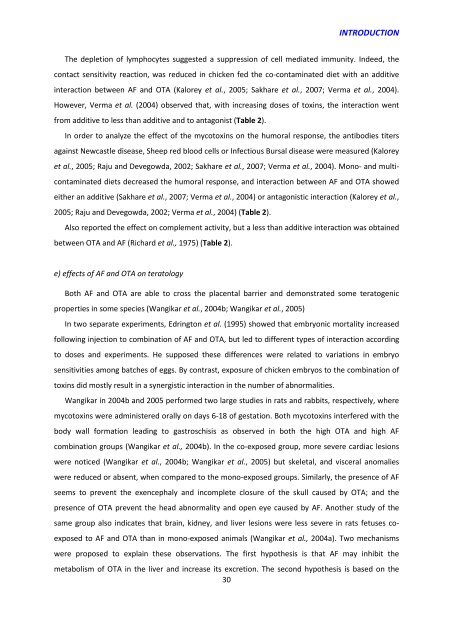Effet chez le porcelet d'une exposition à un régime co-contaminé en ...
Effet chez le porcelet d'une exposition à un régime co-contaminé en ...
Effet chez le porcelet d'une exposition à un régime co-contaminé en ...
Create successful ePaper yourself
Turn your PDF publications into a flip-book with our unique Google optimized e-Paper software.
INTRODUCTIONThe dep<strong>le</strong>tion of lymphocytes suggested a suppression of cell mediated imm<strong>un</strong>ity. Indeed, the<strong>co</strong>ntact s<strong>en</strong>sitivity reaction, was reduced in chick<strong>en</strong> fed the <strong>co</strong>-<strong>co</strong>ntaminated diet with an additiveinteraction betwe<strong>en</strong> AF and OTA (Kalorey et al., 2005; Sakhare et al., 2007; Verma et al., 2004).However, Verma et al. (2004) observed that, with increasing doses of toxins, the interaction w<strong>en</strong>tfrom additive to <strong>le</strong>ss than additive and to antagonist (Tab<strong>le</strong> 2).In order to analyze the effect of the my<strong>co</strong>toxins on the humoral response, the antibodies titersagainst Newcast<strong>le</strong> disease, Sheep red blood cells or Infectious Bursal disease were measured (Kaloreyet al., 2005; Raju and Devegowda, 2002; Sakhare et al., 2007; Verma et al., 2004). Mono- and multi<strong>co</strong>ntaminateddiets decreased the humoral response, and interaction betwe<strong>en</strong> AF and OTA showedeither an additive (Sakhare et al., 2007; Verma et al., 2004) or antagonistic interaction (Kalorey et al.,2005; Raju and Devegowda, 2002; Verma et al., 2004) (Tab<strong>le</strong> 2).Also reported the effect on <strong>co</strong>mp<strong>le</strong>m<strong>en</strong>t activity, but a <strong>le</strong>ss than additive interaction was obtainedbetwe<strong>en</strong> OTA and AF (Richard et al., 1975) (Tab<strong>le</strong> 2).e) effects of AF and OTA on teratologyBoth AF and OTA are ab<strong>le</strong> to cross the plac<strong>en</strong>tal barrier and demonstrated some teratog<strong>en</strong>icproperties in some species (Wangikar et al., 2004b; Wangikar et al., 2005)In two separate experim<strong>en</strong>ts, Edrington et al. (1995) showed that embryonic mortality increasedfollowing injection to <strong>co</strong>mbination of AF and OTA, but <strong>le</strong>d to differ<strong>en</strong>t types of interaction ac<strong>co</strong>rdingto doses and experim<strong>en</strong>ts. He supposed these differ<strong>en</strong>ces were related to variations in embryos<strong>en</strong>sitivities among batches of eggs. By <strong>co</strong>ntrast, exposure of chick<strong>en</strong> embryos to the <strong>co</strong>mbination oftoxins did mostly result in a synergistic interaction in the number of abnormalities.Wangikar in 2004b and 2005 performed two large studies in rats and rabbits, respectively, wheremy<strong>co</strong>toxins were administered orally on days 6-18 of gestation. Both my<strong>co</strong>toxins interfered with thebody wall formation <strong>le</strong>ading to gastroschisis as observed in both the high OTA and high AF<strong>co</strong>mbination groups (Wangikar et al., 2004b). In the <strong>co</strong>-exposed group, more severe cardiac <strong>le</strong>sionswere noticed (Wangikar et al., 2004b; Wangikar et al., 2005) but ske<strong>le</strong>tal, and visceral anomalieswere reduced or abs<strong>en</strong>t, wh<strong>en</strong> <strong>co</strong>mpared to the mono-exposed groups. Similarly, the pres<strong>en</strong>ce of AFseems to prev<strong>en</strong>t the ex<strong>en</strong>cephaly and in<strong>co</strong>mp<strong>le</strong>te closure of the skull caused by OTA; and thepres<strong>en</strong>ce of OTA prev<strong>en</strong>t the head abnormality and op<strong>en</strong> eye caused by AF. Another study of thesame group also indicates that brain, kidney, and liver <strong>le</strong>sions were <strong>le</strong>ss severe in rats fetuses <strong>co</strong>exposedto AF and OTA than in mono-exposed animals (Wangikar et al., 2004a). Two mechanismswere proposed to explain these observations. The first hypothesis is that AF may inhibit themetabolism of OTA in the liver and increase its excretion. The se<strong>co</strong>nd hypothesis is based on the30

















